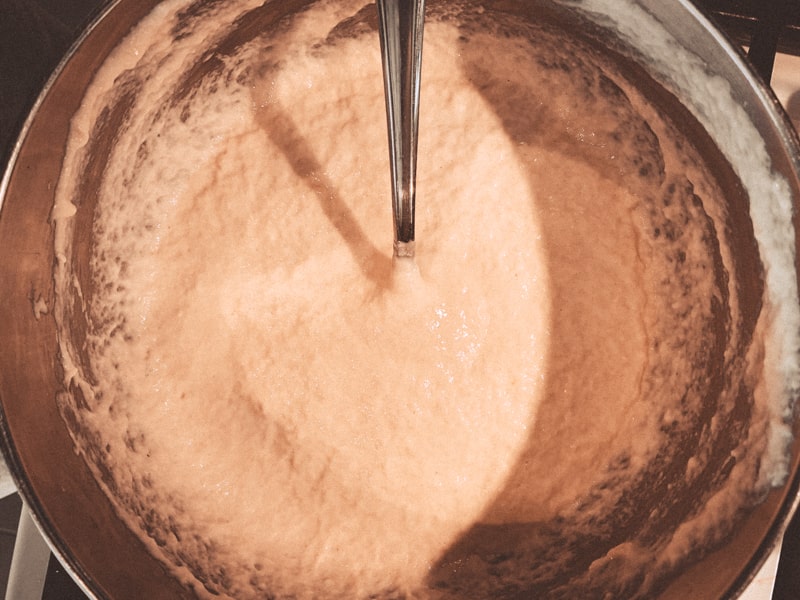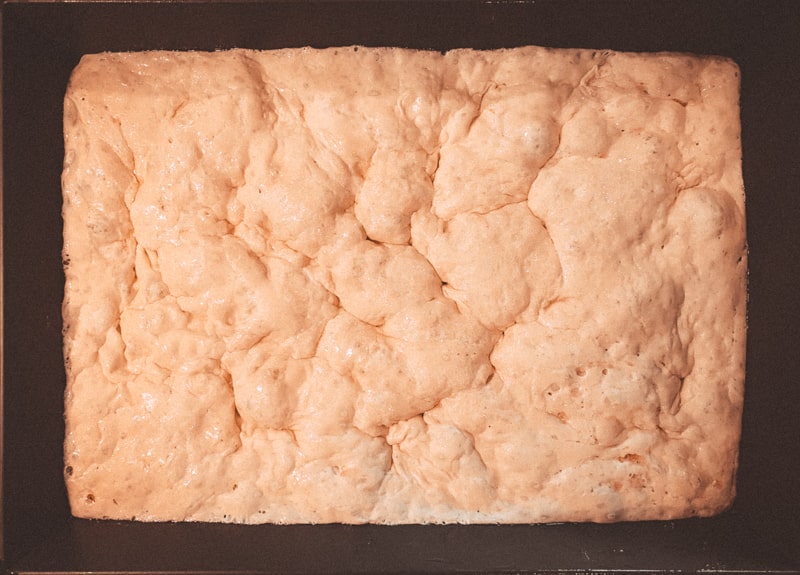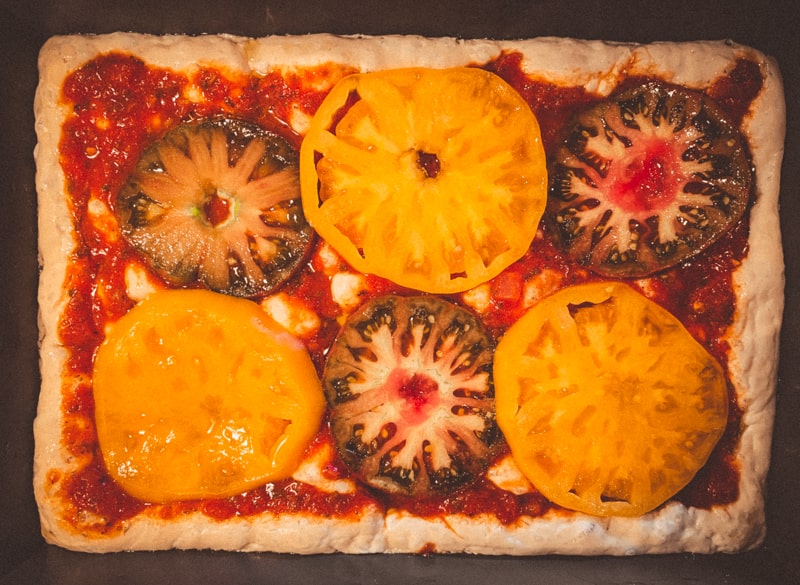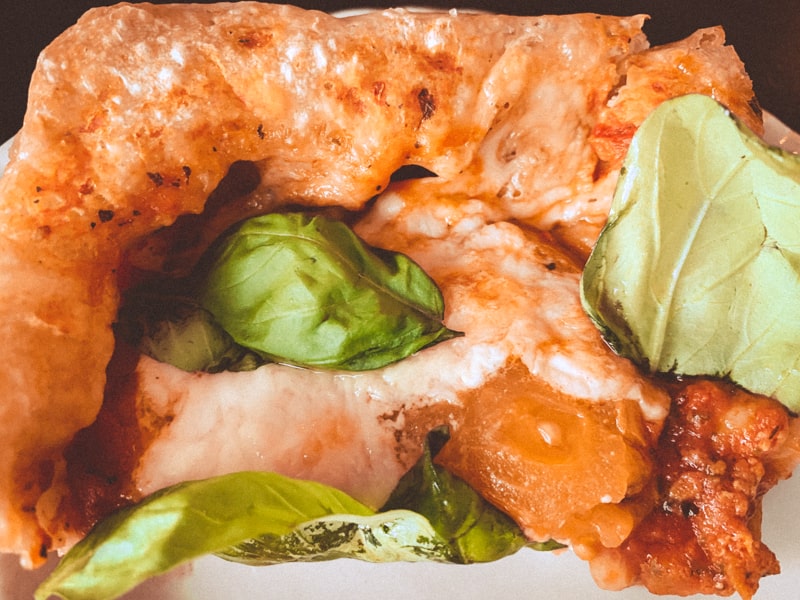Ratings, percentages, and more
rating: 9/8 slices

hydration: 100%

difficulty: easy

Ingredient percents
| Ingredient | Standard % | Baker’s % |
| Flour (448g) | 48.08% | 100% |
| Salt (6.25g)* | 0.67% | 1.40% |
| Yeast (4.5g)* | 0.48% | 1.00% |
| Water (448g) | 48.08% | 100% |
| Olive Oil (25g) | 2.68% | 5.58% |
*The recipe calls for 1.5 teaspoons yeast and 1.25 teaspoons of salt and I measured both. I pulled the yeast weight from King Arthur and the salt weight from Epicurious.
This chart shows the standard ingredient percentages — how you’d normally calculate percentages — in the second column. For the standard percent, I added up all the ingredients and then divided that number by each individual ingredient and rounded to the second decimal (i.e. 448g flour / 931.75g total = 48.08%) The third column shows the “baker’s percentage,” which this post explains well.
Summary
- I first made this on September 9, 2021.
- Effort to result payoff is extremely high.
- The highest hydration dough I’ve ever tried.
- Make sure to review my cooking notes.
See Recipe on Giadzy & this page, talking about the recipe.
So Fast and So Good!

Wow — this crust has everything – crisp bits, doughy bits, dense areas, light bits, nooks, crannies — everything. The outside is crisp, almost fried in the oil you add to the pan. After you get through the initial layer of crunch, the crust is either doughy or light and airy. What you get depends on if the crust section is under a tomato slice or not. This is a great dough, not only because of how it tastes but also for how quickly and easily you can get it together.
A Highly Hydrated Dough

The recipe says it will produce a “very wet” dough but also talks about needing to stretch it out in the pan. When I’ve made the recipe, stretching wasn’t necessary because the wet dough just flowed into the corners. To be honest, I think I may have made this dough with a higher hydration than the recipe intended. See, when I saw the recipe used volume for flour, instead of weight, I tried to convert to weight using a converter I found online. I think the conversion under calculated the flour. Anyway, to duplicate my results, I recommend using the flour and water weights I layout below.
Key Edits & Notes for Successfully Duplicating My Results

As I said, the dough is crazy wet. When I first made it, I struggled but managed to resist urge to add more flour. I’m glad I did because if I’d followed my instincts, I never would have had the great result I did. To help you can duplicate my results, here are the exact measurements I used for water and flour:
- 448 grams of King Arthur bread flour.
- 448 grams of filtered water.
And, here are a few more notes that should help make this recipe a story of success:
- I do about 12 minutes of hand mixing with a metal spoon.
- Don’t try to spread sauce, just dollop it.
- Bake for 40 mins at 405.
- Let it rest in the pan for 10+ minutes, as suggested.
- Be generous with EVOO in pan — I double what the recipe suggests.
- Use a non-stick pan. I had great results with both my Lloyd’s and Monfish Detroit style pans. I haven’t tried it but would expect sticking issues with the untreated sheet pan the recipe suggests.
- Adjust dough amount to match your pan size — see below for what I did with my Detroit pans. (I did also make this once with the full dough recipe in my 10×14 inch Lloyd’s pan — it turned out well but there were more doughy areas than some may want.)
Something for future exploration…I currently do not have a stand mixer and mix everything by hand. When mixing a stiff dough, it can be very hard and I’ve ended up with blistered hands by the end. However, this wet dough made 12 minutes of hand mixing doable. I wonder if you could achieve this mixing ease with other recipes by adding most of the flour, mixing, then adding the rest of the flour right at the end.
Tomatoes on Top

While the heirloom tomatoes look great, you might omit them or slice them thinner. Their weight and water content lead to some doughy, underdone areas, and in some parts broke through the crust. Although, as I mentioned, there is something magical about those areas where the sauce, dough and tomatoes merge together into a delicious, creamy bite. If you use tomatoes, make sure to salt them well.

A Cold Crust Loses its Crisp
When you eat this cold, you’ll notice that the crust loses all its crisp. This does make you notice the dough’s tenderness, which, not surprisingly, will remind you of focaccia. It’s not bad cold but definitely better hot.
This one might be even better when reheated. I think you could bake it the night before, then reheat the entire thing the day of service. I’ll need to try this to confirm though.
A Detroit Conversion

This recipe reminded me a little of Peter Reinhart’s Detroit-style pizza recipe, so, on January 9th, 2022, I decided to make it as a Detroit-style pizza. It turned out well — among the best Detroit-styles I’ve produced.
Just like the suggested recipe, this iteration has it all: an insanely crisp crust; bits of slightly undercooked creamy dough that have melded with the toppings; and light, airy sections, where there isn’t any sauce. The crust was thinner than most Detroit pizzas, at least where there was sauce.
Next time I make this, I may bake with just cheese and pepperoni, then add the sauce after. This might lead to an even crisper crust. Here are a few more notes from my Detroit experience:
- Separated out 400g of dough before first rise and fold.
- For the in-pan rise, I put 400g of dough in my Monfish pan and the rest in my Lloyd pan (the Monfish baked version came out crisper).
- Topped heavily — might go a little lighter than a standard Detroit pizza next time because of the dough’s delicacy.
- Cooked at 405 for 30 minutes — came out well — just a few small doughy bits, which I like, but you might go a few minutes more if you don’t.
Regardless of whether you go for a Detroit style version, stick to the suggested toppings, or go with something all your own, this recipe is excellent, especially when you’re pressed for time.
The Lesson
Pouring a dough into a pan, might make you think you’re baking a cake. Don’t deviate, and a delicious pizza you’ll make.
